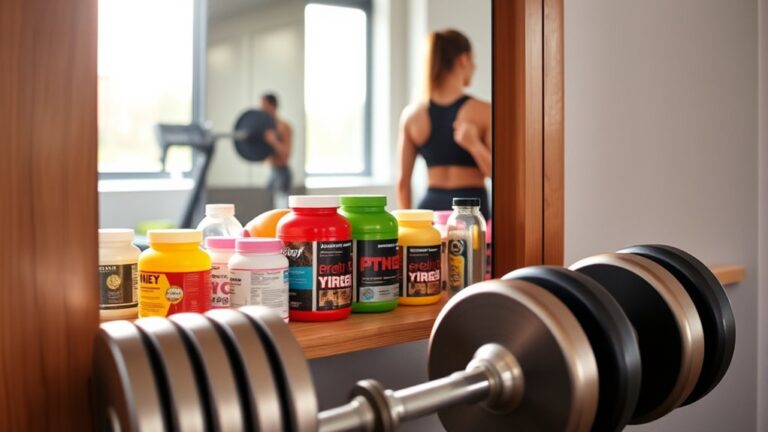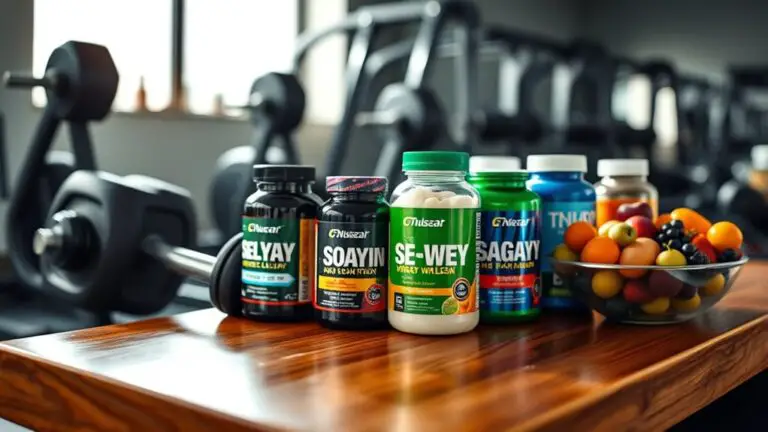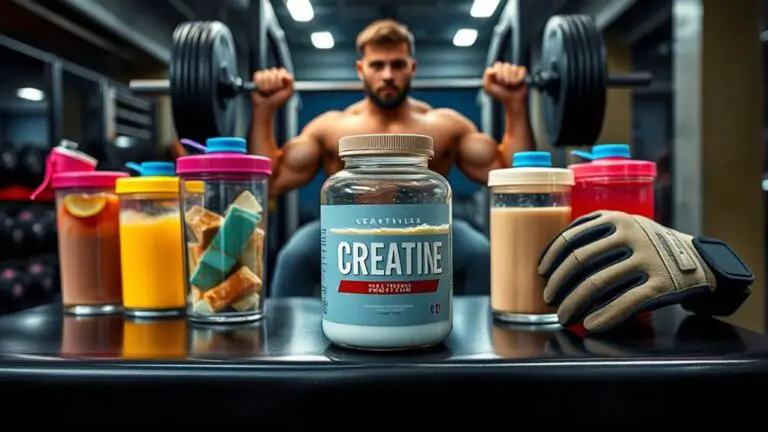How to Meal Prep for a Gym-Focused Lifestyle
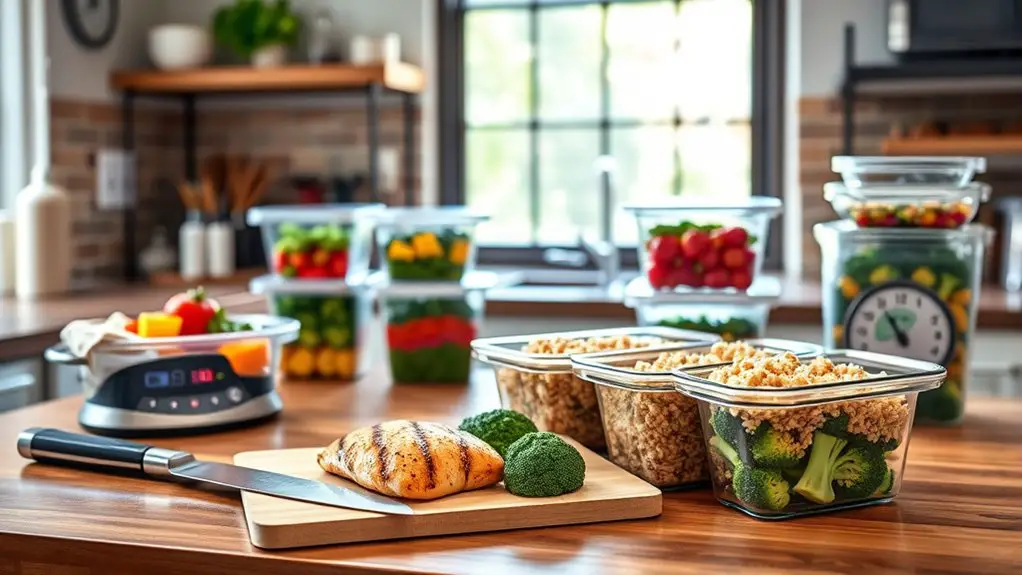
To meal prep for a gym-focused lifestyle, start by understanding your nutritional needs. Balance your macronutrients—carbs for energy, proteins for muscle gain, and healthy fats. Plan meals weekly and incorporate batch cooking to save time and guarantee nutrient-rich options are ready. Use airtight containers for storage and label them for freshness. Stick to a grocery list to avoid impulse buys. This approach not only keeps you on track but also sets you up for long-term success in your fitness journey. Discover more tips to elevate your meal prep game!
Understanding Your Nutritional Needs
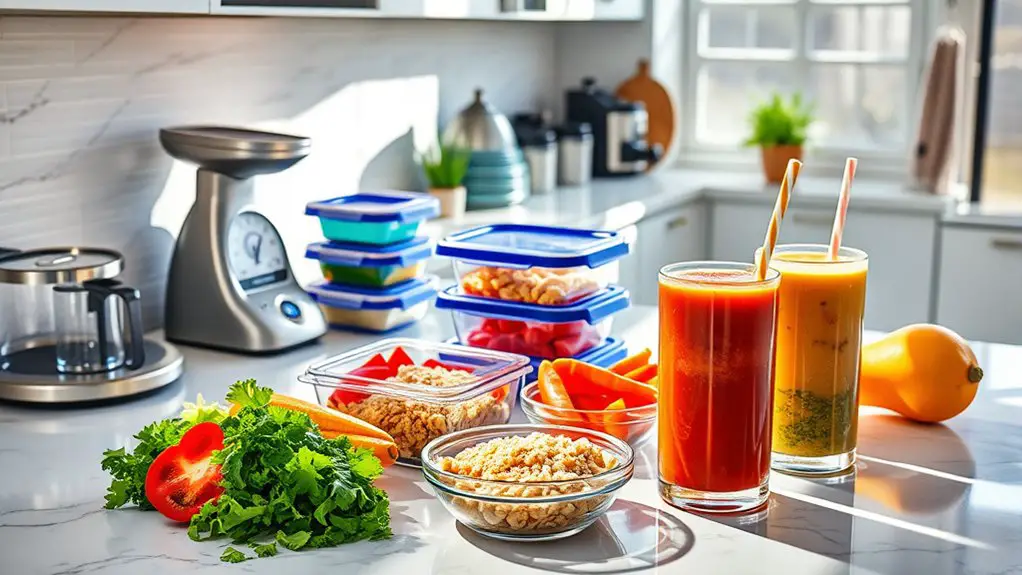
When you’re committed to a gym-focused lifestyle, understanding your nutritional needs becomes essential for achieving your fitness goals. A solid foundation starts with a proper macronutrient breakdown. You’ll need to balance carbohydrates, proteins, and fats based on your activity level and objectives. For muscle gain, aim for higher protein intake, while endurance training might require more carbohydrates.
Calorie tracking is another critical aspect. By monitoring your daily caloric intake, you can guarantee you’re consuming enough to fuel your workouts without exceeding your energy needs. Use apps or food journals to keep tabs on what you eat.
Planning Your Meals
To effectively support your gym-focused lifestyle, planning your meals is essential for staying on track with your nutrition goals. Proper meal planning helps you manage meal timing and portion control, guaranteeing you fuel your workouts and recover effectively.
Here are three key strategies to contemplate:
- Map Out Your Week: Dedicate time to plan your meals for the week, aligning them with your workout schedule.
- Focus on Balanced Nutrition: Include a mix of proteins, carbohydrates, and healthy fats in each meal to enhance performance and recovery.
- Control Portions: Use measuring tools to guarantee your servings align with your caloric and macronutrient targets.
Choosing the Right Containers
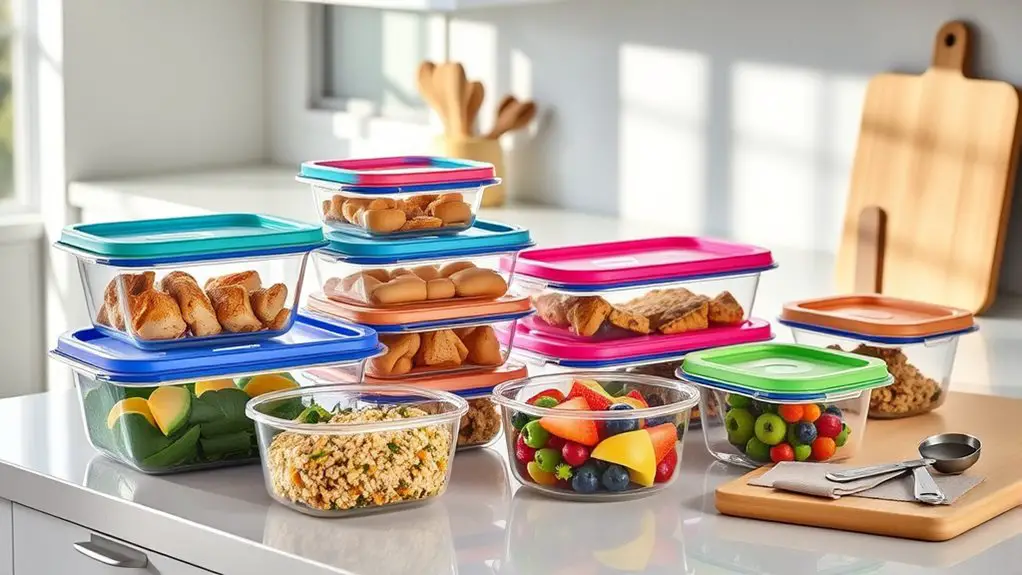
Choosing the right containers for your meal prep can greatly impact how well you stick to your nutrition plan. Start by considering container materials. Glass containers are durable, microwave-safe, and won’t stain or retain odors, making them a popular choice. Plastic containers are lightweight and often more affordable, but look for BPA-free options to guarantee safety.
Next, think about portion sizes. Choose containers that align with your meal portions to help you control calorie intake. Smaller containers are great for snacks or sides, while larger ones work well for main meals. Having a variety of sizes can simplify your meal prep, making it easier to mix and match.
Ultimately, investing in high-quality containers that suit your lifestyle will keep your meals fresh and organized, making it easier to stick to your gym-focused nutrition goals.
Grocery Shopping Tips
Although grocery shopping can sometimes feel overwhelming, having a strategic approach can make it easier to stock up on nutritious foods that align with your gym-focused lifestyle. Here are some tips to streamline your shopping experience:
Grocery shopping can be simplified with a strategic approach to stocking nutritious foods for your fitness journey.
- Prioritize organic produce: Whenever possible, choose organic fruits and vegetables to reduce pesticide exposure and increase nutrient intake.
- Explore budget-friendly options: Look for seasonal produce or sales on quality proteins to save money while eating well.
- Plan meals ahead: Create a shopping list based on your meal prep plans to avoid impulse buys and guarantee you get everything you need.
Batch Cooking Techniques
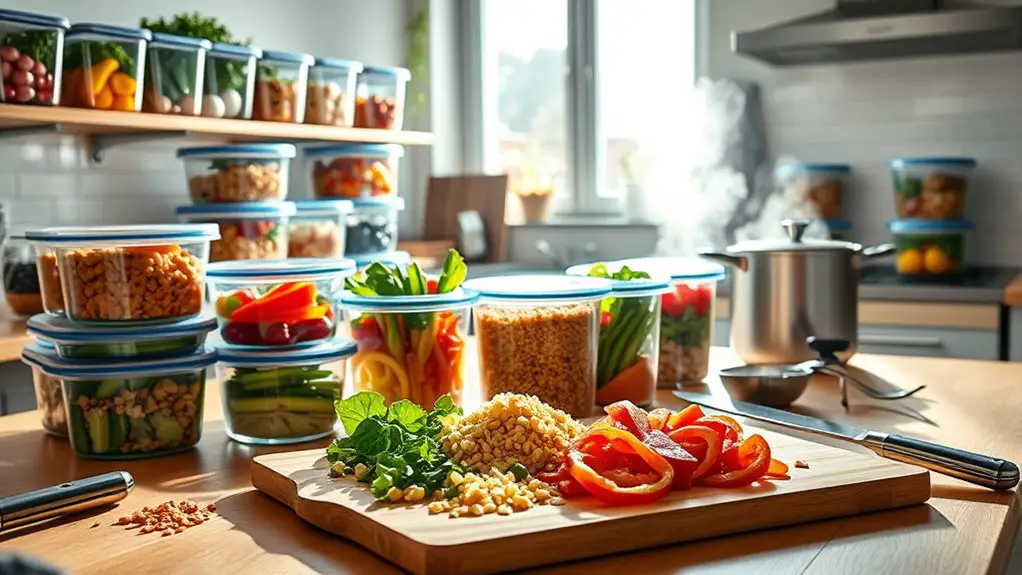
Batch cooking is a powerful technique that can save you time and guarantee you’re fueling your body with healthy meals throughout the week. One effective method is to utilize slow cooking. By preparing ingredients in a slow cooker, you can create flavorful stews or protein-rich dishes with minimal effort. Simply set it up in the morning, and by dinner, you’ll have a nutritious meal ready to enjoy.
Another great strategy is to prepare freezer meals. Cook larger portions of your favorite recipes and divide them into individual servings before freezing. This way, you can easily grab a meal on a busy day, ensuring you stick to your nutrition goals without reaching for unhealthy options. Just remember to label your meals with dates and contents for easy access. By incorporating these batch cooking techniques, you’ll simplify your meal prep and maintain a gym-focused lifestyle with wholesome, home-cooked food at your fingertips.
Storing and Reheating Meals
Once you’ve prepared your meals, the next step is knowing how to store and reheat them properly to maintain their taste and nutritional value. Effective meal storage not only prevents spoilage but also makes your meal prep more convenient. Here are some tips to keep your meals fresh:
After preparing your meals, mastering proper storage and reheating techniques is essential for freshness and nutritional value.
- Use airtight containers to minimize air exposure.
- Label your meals with dates to guarantee you consume them within the recommended time frame.
- Store meals in portion sizes to make reheating easier.
When it comes to reheating methods, consider these options:
- Microwave for quick meals, guaranteeing even heating.
- Oven for crispy textures, especially for baked dishes.
- Stovetop for soups or stews to maintain flavor.
Incorporating Variety in Your Meals
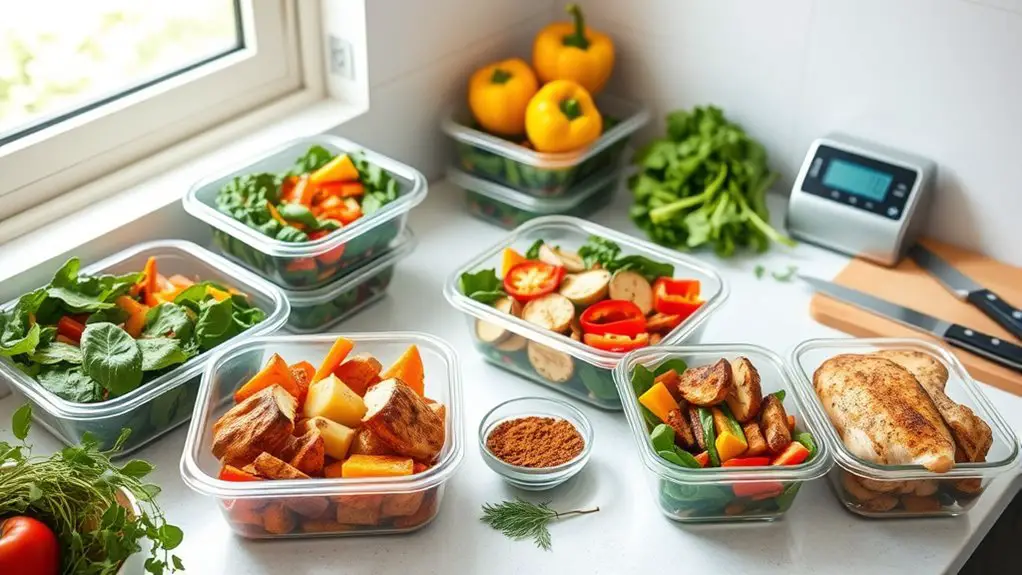
Incorporating variety in your meals is essential not only for keeping your taste buds satisfied but also for ensuring you get a range of nutrients. To achieve this, start by exploring diverse meal inspiration from different cuisines. For example, instead of sticking to chicken and broccoli, try a Mediterranean quinoa salad or a spicy Thai stir-fry.
Experimenting with various flavor profiles can elevate your meals; think sweet, savory, spicy, and sour. Use herbs and spices to add depth without extra calories.
Another practical tip is to rotate your protein sources—swap chicken for fish or plant-based options like lentils and chickpeas. Incorporating seasonal vegetables not only enhances freshness but also introduces new textures and tastes.
Staying Motivated With Meal Prep
While meal prepping can seem challenging at first, staying motivated is essential for making it a sustainable part of your gym-focused lifestyle. Here are some practical strategies to boost your meal prep motivation:
Meal prepping may feel daunting initially, but maintaining motivation is crucial for integrating it into your fitness routine.
- Set clear goals: Define what you want to achieve with your meal prep—whether it’s saving time, eating healthier, or supporting your fitness goals.
- Find accountability partners: Team up with a friend or fellow gym-goer. Sharing your meal prep plans can keep you accountable and make the process more fun.
- Celebrate small wins: Acknowledge your efforts, even if they seem minor. Celebrating progress can reinforce your commitment to meal prep.
Adjusting Your Meal Prep for Progress
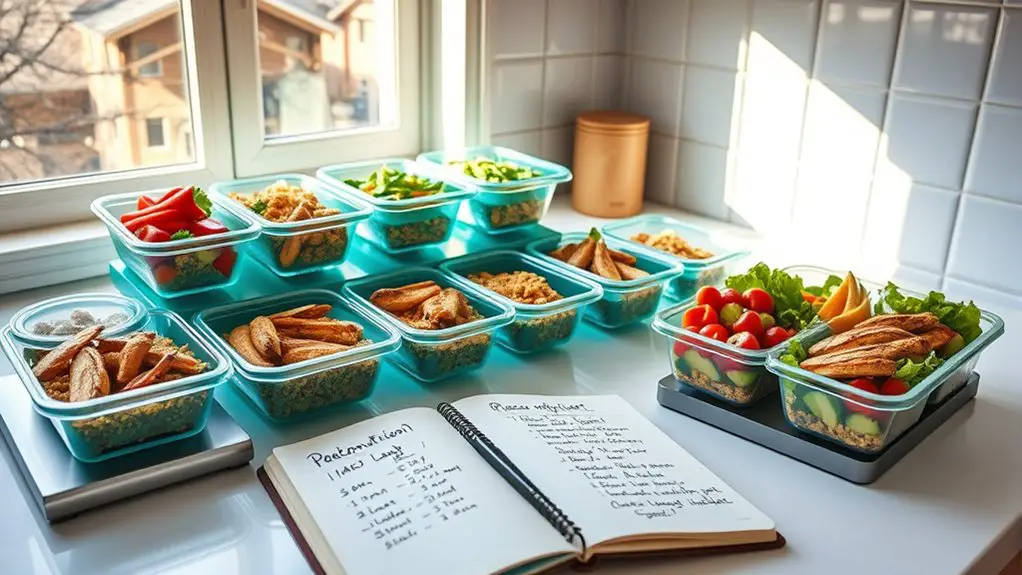
As you progress in your fitness journey, adjusting your meal prep can be a game-changer for optimizing your results. Start by evaluating your caloric needs; as you gain muscle or lose weight, these requirements will shift. Use a reliable online calculator or consult a nutritionist for personalized guidance.
Next, focus on your macronutrient ratios. For muscle gain, consider increasing protein intake to around 1.6 to 2.2 grams per kilogram of body weight, while adjusting carbs and fats accordingly. Conversely, if you’re cutting, you might want to increase protein while reducing carbs to preserve muscle mass.
Don’t forget to track your meals to guarantee you’re hitting your targets. This allows you to make informed adjustments based on your progress. Remember, meal prep isn’t just about convenience; it’s an essential tool for reaching your fitness goals effectively.
Frequently Asked Questions
How Often Should I Change My Meal Prep Routine?
You should change your meal prep routine every 4 to 6 weeks to keep things fresh and exciting. This meal prep frequency helps prevent boredom and guarantees you’re getting a variety of nutrients. Implement meal variety strategies, like rotating proteins, grains, and vegetables. Experimenting with different herbs and spices can also revitalize your meals. Staying adaptable not only keeps you engaged but also supports your overall health and wellness goals.
Can I Meal Prep for Dietary Restrictions?
Absolutely, you can meal prep for dietary restrictions! It’s not just possible; it’s a culinary revolution waiting to happen! With a little creativity, you can discover a world of dietary alternatives that fit your needs. Think gluten-free grains, dairy substitutes, or plant-based proteins. Meal flexibility is key—experiment with flavors and textures to keep things exciting. By planning ahead, you’ll guarantee your meals are both nutritious and aligned with your dietary preferences.
What Snacks Complement a Gym-Focused Meal Prep?
When picking snacks to complement your meal prep, consider protein-packed options like Greek yogurt, hard-boiled eggs, or cottage cheese. These not only keep you full but also support muscle recovery. You might also want to include healthy fat options such as nuts, seeds, or avocado. These snacks provide essential nutrients and energy for your workouts, helping you stay fueled throughout the day while maintaining a balanced diet.
How Do I Calculate Portion Sizes for Meals?
You might think portion control is just a fancy way to serve tiny meals, but it’s essential for balanced eating. To calculate serving sizes, start by using the plate method: fill half your plate with veggies, a quarter with lean protein, and a quarter with whole grains. Weighing and measuring can help too. Aim for about 20-30 grams of protein per meal, adjusting based on your goals and activity level.
Is It Safe to Freeze and Reheat Meals Multiple Times?
It’s generally not safe to freeze and reheat meals multiple times due to meal safety concerns. Each time you thaw and reheat food, you increase the risk of bacterial growth. According to freezing guidelines, it’s best to freeze meals in single portions and reheat only what you plan to eat. This way, you maintain quality and minimize health risks. Always guarantee meals are heated thoroughly before consumption to further secure safety.

